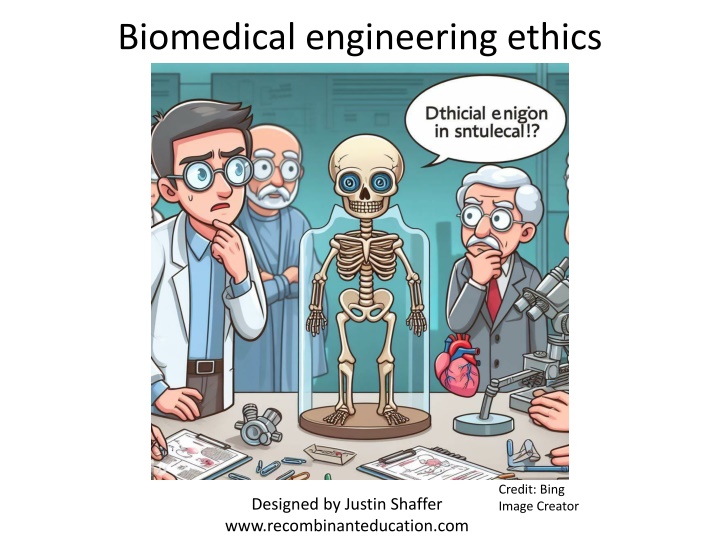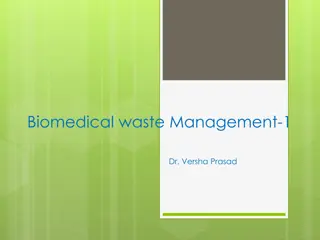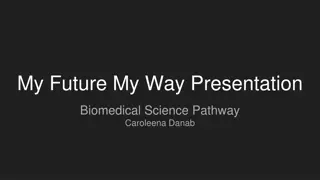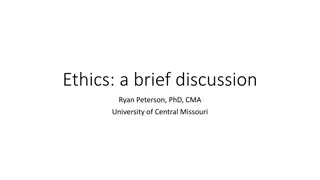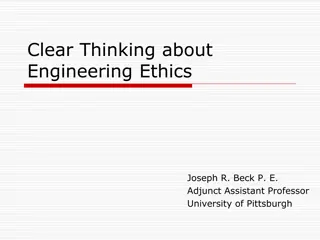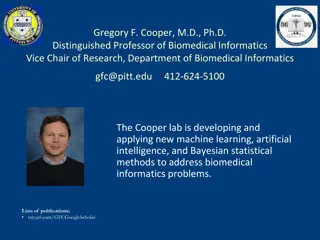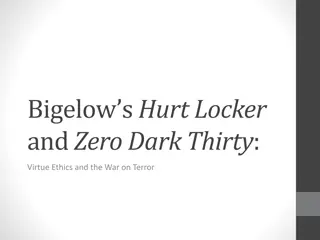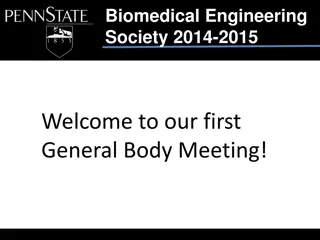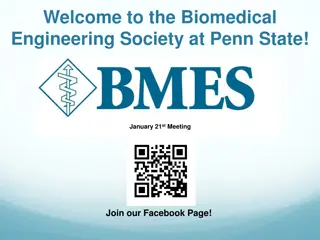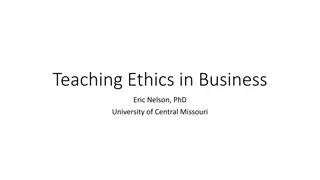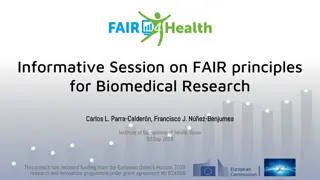Importance of Ethics in Biomedical Engineering Decision Making
Biomedical engineering ethics play a crucial role in decision-making processes within the field, influencing product design and treatment development. This article explores the significance of ethical considerations in biomedical engineering, evaluating ethical dilemmas, stakeholders to be considered, and the BMES code of ethics. It highlights various case studies and resources related to ethics in bioengineering while emphasizing the need for ethical awareness in the industry.
Download Presentation

Please find below an Image/Link to download the presentation.
The content on the website is provided AS IS for your information and personal use only. It may not be sold, licensed, or shared on other websites without obtaining consent from the author.If you encounter any issues during the download, it is possible that the publisher has removed the file from their server.
You are allowed to download the files provided on this website for personal or commercial use, subject to the condition that they are used lawfully. All files are the property of their respective owners.
The content on the website is provided AS IS for your information and personal use only. It may not be sold, licensed, or shared on other websites without obtaining consent from the author.
E N D
Presentation Transcript
Biomedical engineering ethics Credit: Bing Image Creator Designed by Justin Shaffer www.recombinanteducation.com
Learning Objectives Explain the importance of considering ethics when making design decisions in BME Evaluate ethical situations related to BME
PodCase: BME Ethics Credit: Spotify
Brigham Buhler Founder of Ways2Well, a functional and regenerative care clinic, and of ReviveRX, a pharmacy focusing on health, wellness, and restorative medicine Former medical equipment and pharmaceutical representative for Eli Lilly and Stryker for 15 years https://ways2well.com/company/meet-the-team
Credit: Spotify Play from 0:04:17 to 0:05:34 Link to full episode: https://open.spotify.com/episode/4mCXtp4ylKsOX5fHx6Qzd9?si=35165f38fd1647bf Why are ethics so important in BME?
What kinds of ethics should biomedical engineers be concerned about? What stakeholders should be considered when designing a new product or treatment?
BMES code of ethics https://www.bmes.org/bmes2023-policies
https://www.frontiersin.org/articles/10.3389/fbioe.2022.949280/fullhttps://www.frontiersin.org/articles/10.3389/fbioe.2022.949280/full https://array.aami.org/doi/10.2345/0899-8205-43.3.196 https://crimsonpublishers.com/sbb/fulltext/SBB.000505.php
Ethics case studies https://www.scu.edu/ethics/focus- areas/more-focus-areas/engineering- ethics/engineering-ethics- cases/bioengineering-cases/ The following three cases are from the Markkula center
Satomi works in a research facility that provides statistical results for the bioengineering firm TechCureCase. She is one of four interns expected to go through hundreds of samples per day. At her first week on the job, her supervisor informs her that all blood samples are to be completely anonymous. No testing can be done if personal information is revealed meaning, the samples must be properly disposed of if opened, or returned to the physicians if unopened to be re-anonymized. For the first five weeks, most of the new interns follow procedures to check that samples were anonymized before testing occurred. However, one of the interns, Max, failed to verify whether the samples were anonymized. Halfway through the testing, Satomi discovers the non-anonymized samples. She considers whether they should tell their supervisor, but the other interns ask her not to speak up so that they won t get in trouble. One of the interns argues that as long as they remove the information from the non- anonymized samples, the batch would otherwise be fine. Max is hesitant to go to their supervisor as it is his fault, but Satomi can see that neither does he like the idea the other interns are suggesting. What should Satomi do?
Milo recently got hired to work in the technical research department of TechCureCase, a bioengineering firm that develops new medical devices for more accurate diagnostic testing of prostate cancer. Milo performs numerous tests to determine the success rate of a new medical device the company is testing. While nearly 98% of the known samples have produced correct results, a few samples have proven to have incongruous results. During this longitudinal study, results from one of the negative control samples surprises Milo as it changes from being consistently negative to being consistently positive for early stage prostate cancer. As no device has perfect sensitivity and specificity, he initially believes the change is due to is a false positive result or mislabeling during processing, and therefore dismisses it. However, the next sample from the same negative control patient again produces the same positive result. Milo becomes certain there is either a technical issue going on with the test, or the patient has actually developed prostate cancer. When Milo talks about the issue with his boss, Milo s boss tells him to put the issue aside and focus on the rest of his work. What should Milo do?
Willows company has been contracted to oversee data management for a clinical trial. The trial is being conducted on a newly developed drug and consists of applying the drug on the subject s skin and monitoring the effects the drug has. This trial is in the first phase of testing, meaning the goal of the trial to determine if the drug is safe for human use. What should Willow do? The drug is applied topically and the rate at which the drug is absorbed into the subject s skin is monitored. After data had been collected from all the subjects participating in the trial, Willow analyzed the data and found that there was a wide range in the rate at which the drug was absorbed. All subjects were given the same dosage amount, and it was expected that the drug would be absorbed at a slow, constant rate. Some subjects showed this trend, while others absorbed the drug at a high rate, meaning a high concentration of the drug quickly entered their system. This was cause for concern because absorbing the drug at a high rate could lead to serious health consequences for the potential users of the drug. Willow reported her findings to her client, the company which had developed the drug. Her report outlined the wide range in rate at which the drug was absorbed. The client was unsatisfied with the report and asked Willow to re-analyze the data. However, this time they requested a report which contained only the average rate at which the drug is absorbed. Willow knows that a report which only presents the average rate of absorption will not show all the safety concerns shown in the clinical trial data. However, her client ensures her that her report will only be used to show investors that the drug has progressed to clinical trials. Additionally, the company assures her that they are fully aware of the safety concerns associated with the drug and are currently researching methods to fix these problems.
Suppose you are designing an artificial heart What ethical considerations do you need to make? What stakeholders are involved? How would you know if you are ethically successful in your product development? Robert Jarvik with the Jarvik-7, the first successfully implanted human heart Credit: https://pivotcenter.utah.edu/success-stories/the-jarvik-heart/
What happened with the use of a shaver device for surgeries? Credit: Spotify Play from 0:44:52 to 0:46:07 Link to full episode: https://open.spotify.com/episode/4mCXtp4ylKsOX5fHx6Qzd9?si=35165f38fd1647bf
